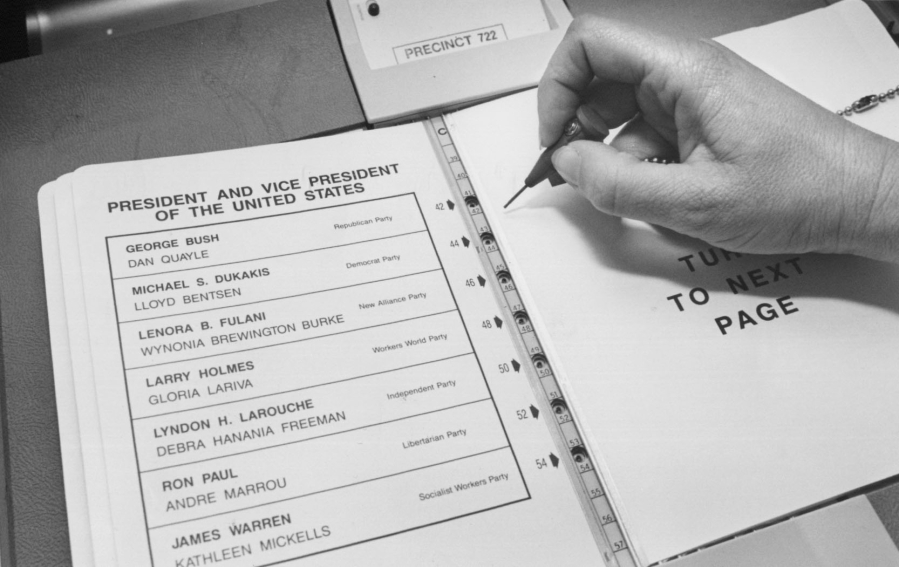Clark County is pretty good at picking presidents.
Since 1900, the majority of county voters chose the victor in the presidential election 25 of 29 times, missing the mark on only four occasions.
That track record isn’t quite good enough to earn us the so-called bellwether moniker pundits love to toss around this time of year, but political science professor Jim Moore says the county is definitely “a strong indicator” of how national elections might go. That is partly because Clark County has had similar demographics to the nation as a whole over the years, added Moore, who teaches at Pacific University in Oregon.
The last time Clark County picked the losing presidential candidate was in the ’80s. In 1988, 51.1 percent of the county voted for Democrat Michael Dukakis over Republican George H.W. Bush, who collected 47.6 percent of the county vote.
County voters also didn’t reflect the nation’s views in 1968, when they chose Democrat Hubert H. Humphrey instead of Republican Richard Nixon; in 1956, when they picked Democrat Adlai Stevenson over Republican Dwight D. Eisenhower; and way back in 1916, when they supported Republican Charles Evan Hughes rather than incumbent Democrat Woodrow Wilson.
Political shifts
Before 1932, the county typically voted Republican, including one of the county’s misses — the 1916 wartime vote for Hughes over Wilson. Interestingly, Wilson is the only Democrat who won from 1900 to 1928 in this county, but even that was arguably an anomaly because 1912 featured one of the more contentious and fractured presidential elections of the 20th century.
Wilson got help in this county, much like he did nationwide, from a divided conservative base split between Republican Howard Taft and Bull Moose independent Theodore Roosevelt. At the same time, though, Wilson faced a challenge from the left in Socialist Eugene V. Debs. That year, 34 percent of the county voted for Wilson, 28 percent for Roosevelt, 25 percent for Taft and 13 percent for Debs.
In 1932, a big shift came in the county following onset of the Great Depression and the election of Democrat Franklin D. Roosevelt.
From the 1930s to 1970s, and even into the 1980s, Clark County was “a port county and a timber county and (had) people that worked on the dams,” Moore said. “It’s a time period when the Republican Party was seen as an elitist party.”
Labor’s effect on the county’s demographics was felt during and long after World War II, with the shipyards in Vancouver and a housing boom that increased demand for timber. An increasing labor force turned the county blue for quite some time, and that could explain why the county picked Democrats who lost in the 1956, 1968 and 1988 presidential elections.
That blue started to fade in the 1980s, said Dan Ogden, a longtime local resident who has served as chairman of the Clark County Democratic Party.
Moore agreed that the county’s demographics started to shift away from favoring Democrats in the ’80s. That shift eventually led to Republican Linda Smith ousting Democratic U.S. Rep. Jolene Unsoeld in 1994 in the 3rd Congressional District.
County Auditor Greg Kimsey, a Republican, said 1994 was a “watershed moment” for the county in terms of beginning to lean Republican. He noted that some local seats long held by Democrats fell to Republicans, including state lawmaker Don Benton, who was first elected to the Legislature that year.
That shift also gained some momentum in the late ’90s and early 2000s, Kimsey added, with increasing migration from Multnomah County as people crossed the river seeking better schools, cheaper housing or lower taxes.
‘A swing county now’
These days, it’s difficult to determine which way Clark County leans.
Of the county’s three major legislative districts, the rural 18th favors Republican, the urban 49th likes Democrats, and the 17th, including east Vancouver, seems to lean Republican just barely.
“The backbone of the labor movement here has diminished,” Ogden said. “The county has moved to a more central position and is more balanced between Democrats and Republicans. It’s a swing county now.”
A political map of the county, with the blue 49th District surrounded by red, is reminiscent of a map of national election results, with pockets of blue scattered amid a sea of red. For the past couple of decades, Democrats have captured the majority of votes in urban centers while Republicans claimed victory in the outlying rural or semi-rural areas.
For local historian and author Pat Jollota, the state capital of Texas, a Democratic enclave in a red state, comes to mind. “I’ve heard people say Austin is a blueberry on a cherry pie,” said the former Vancouver city councilor.
President Barack Obama won Clark County in 2008 and 2012. The latter election was a nail-biter for Obama in Clark County; he won by 431 votes. Moore said he thinks Obama may have won the county simply because he was the sitting president and not necessarily because another demographic shift is taking shape.
“The incumbency has a huge advantage,” Moore said. “The demographics are so hard to shift.”
Today, Clark County doesn’t share all of the same demographics as the nation as a whole. In particular, the county lacks the nation’s racial diversity. Nationwide, 61.6 percent of residents are non-Hispanic whites, while that number is 79.4 percent in Clark County.
The county, in general, is also better educated, has a smaller percentage of people living in poverty, and a higher median household income when compared to the U.S. as a whole. Economics and education play big roles in how voters see the world and its presidential candidates.
But the county is similar to the rest of the nation in that it shares a similar mix of urban, suburban and rural voters, each with their own political views and values. They also have similar per capita incomes and a comparable mix of homeowners and renters.
Independent streak
Clark County voters also have been known to show an interest in mavericks over the years, Jollota said.
In 1992, for example, nearly 25 percent of the county voted for Independent Ross Perot; nationwide, Perot earned about 19 percent of the popular vote.
The last third-party candidate with any measurable general-election success in the county was the Green Party’s Ralph Nader in 2000 with about 4 percent of the vote. Nationwide, Nader got 2.75 percent of the popular vote that November.
This year, Clark County fell hard during presidential primaries for Bernie Sanders, an Independent who sought the Democratic nomination, and Republican Donald Trump. Sanders received 78.5 percent of the vote in the Democratic caucus in March, but a much lower 51.3 percent in the May primary against Democrat Hillary Clinton. Trump got 76.4 percent in the primary here with Republican U.S. Sen. Ted Cruz coming in second with 10.5 percent.
In the May presidential primary, 50,060 of the county voted Democrat and 44,701 voted Republican, but turnout is much lower in the primary than it is in the general election. More voters could swing the county in one direction or the other.
Voters are fickle and can be surprising on Election Day, Jollota said.
“We are a strange people, aren’t we?” she said. “It looks like the electoral votes are going to go for Clinton, but that could change tomorrow.”




